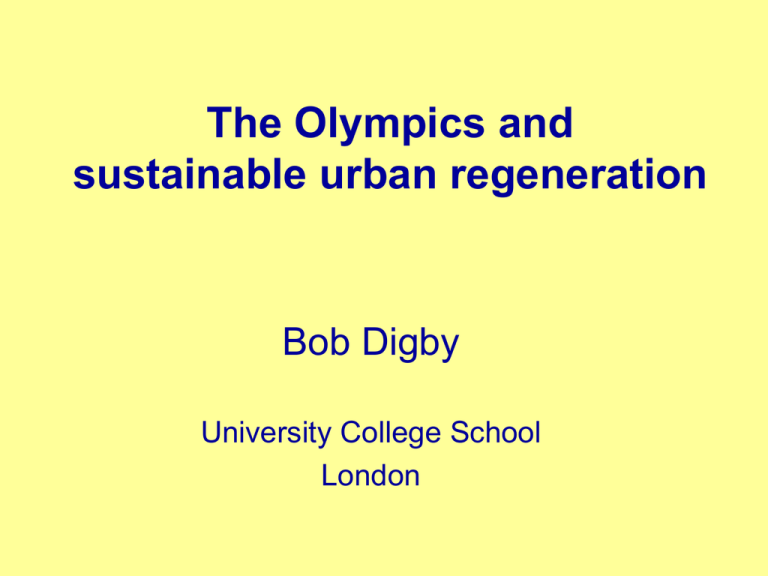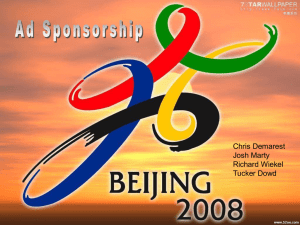London's Olympics Bid
advertisement

The Olympics and sustainable urban regeneration Bob Digby University College School London Introduction Several Olympic bids now have been used to regenerate urban areas. Barcelona began the process in the mid1980s, and now London’s vision for 2012 is the regeneration of one of the poorest parts of the UK. Developments like this are – • Usually large-scale • Developed centrally by governments with a mix of private capital and government investment. • Presented as projects for environmental remediation (e.g. Sydney 2000) or socio-economic regeneration (e.g. London 2012). But are such ‘urban flagship’ developments sustainable? Properly analysed, they can us to understand how and why urban developments might be considered ‘sustainable’ or not. This presentation asks whether these kinds of regeneration are – • successful; i.e. do they achieve what they set out to achieve? • truly representative of what we mean by ‘sustainability’? Sydney’s 2000 Olympics gave a new dimension to urban regeneration: • Olympic projects were seen as a way of regenerating urban areas • Environmental transformation could take place in parts of Sydney that were polluted with toxic waste © Greenpeace • ‘Sustainable principles’ were applied to produce Sydney’s so-called ‘Green Olympics’ This is what the IOC say ….. their criteria for sustainable development The Olympics should provide … “sustainable environmental legacies, such as • • • • rehabilitated and revitalized sites, increased environmental awareness, improved environmental policies and practices, further encouragement and facilitation of strong environmental actions, technology and product development in a city, country and beyond, through the educational value of good example.” Source IOC website (2005) Mission Statement According to the IOC: To be successful, the Olympics should have ‘environmental protection and, more importantly, sustainability’ as prime elements of Games planning and operations. ‘positive legacies’ that last well beyond the Olympics themselves Source IOC website (2005) Mission Statement The Olympics: a major commitment • There are 7 years from the time a city is awarded the Olympics in which to prepare • Schedules are tight and difficult to meet – e.g. 2004 Athens Olympics • The Olympics involve host cities in massive investment and expense; costs are substantial, and implications great, e.g. for mass tourism and accommodation The Olympics - a major undertaking E.g. The 16 days of the London 2012 Games will involve • 11 000 athletes in 300 events, with 5000-6000 coaches & officials, attended by 4000-5000 other members of the Olympic community. • Over 7000 sponsors. • In the Paralympics alone, 4000 athletes and 2500 officials, equivalent to Manchester’s Commonwealth Games in 2003. • 20 000 newspaper, radio, TV, & internet journalists. • Over 9 million tickets in total, and 500,000 spectators a day at events in and around London • 63 000 operational personnel, of whom 47 000 will be volunteers, e.g. as stewards, marshals, and drivers. So – the economic agenda is strong and powerful Host cities have to be able to balance budgets; huge costs versus the revenue benefits. Costs e.g. Land purchase, Construction of stadia, and transport infrastructure, and of hosting the Games themselves (e.g. security) Benefits Direct – Revenue from ticket sales, TV rights, and company sponsorships e.g. to supply drinks or food. Indirect – Land values after re-development However, other indirect benefits may help make a profit: E.g. tourist spending – in hotels, restaurants, VAT etc Sydney’s Olympic story © Bob Digby Olympic Park 2000 © Google Earth Facilities were all together on one site; learning from mistakes made at Barcelona in 1992 where traffic congestion brought gridlock because facilities were spread over the city But Homebush Bay had an industrial history that made regeneration costly and difficult Homebush Bay; its industrial history 5 – worst of all, 1 Newington 4 Wilson’s Park – Union Carbide (Australia) armaments a former coal gas had a chemical plant here Dump – toxins plant, closed in – heavily polluted with and heavy metals the 1970s, turned dioxins into a park, but closed in the 1990s due to 2 Former brickworks pollution - an eyesore 3 Olympic Stadium site was a former landfill site contaminated with household waste © Google Earth Homebush Bay; its industrial history Wilson’s Park – polluted by a former coal gas plant Newington – a former armaments dump © Bob Digby Homebush Bay; its industrial history Newington in 2006 - the site of a former armaments depot and toxic waste dump, described by a firm of US consultants in the early 1990s as containing “the worst contamination ever seen”. Homebush Bay; its industrial history 2005 Newington suburb: the former Olympic Village In the 1990s, dioxin pollution here was 6500x the safe limit for humans © Bob Digby Sydney’s bid was all about clean-up – or remediation – of a previously contaminated industrial site. One firm of US consultants described Homebush Bay in the early 1990s as ‘the most contaminated site in the southern hemisphere’ Greenpeace emphasised a number of aspects of ‘Green’ - or sustainable – development when they put together the winning bid for the 2000 Olympics. Their criteria that they used are shown in the next slide. These criteria – they believe – form the basis of any ‘green’ development. The Greenpeace view of sustainability for Sydney’s 2000 Olympics Submitted as part of a competitive design bid by Greenpeace Australia for the world’s first ‘Green Games’. So – how well did Sydney match up to its intentions? The next slides consider some of the environmental, economic and social issues. Then you can decide for yourself! Were Sydney’s ‘Green’ principles kept to? Before that – you have to do some research into 3 groups! Environmental group Type in ‘Homebush Bay clean up’ into Google and follow the links – especially the Greenpeace link and http://homepage.mac.com/herinst/sbeder/Search-Olympics.html Economic group: Type in ‘economic impacts Sydney Olympics’ into Google and follow the links Social group: Type in ‘social impacts Sydney Olympics’ into Google and follow the links Research these web links and feed back Environmental criteria How well did Sydney match up? Construction should be on ‘brownfield’, and not ‘greenfield’ sites. Homebush Bay was an industrial area, and many past industries had closed. Much of the land was derelict in 1993. But? Existing facilities should be used or adapted, rather than build from scratch Building foundations were recycled concrete and masonry from the demolition of an old abattoir on the site. During the construction of Sydney showground, 95% of waste was recycled. But? Building and design should be environmentally friendly Mostly, non-toxic materials were used, e.g. natural fibre insulation, non-toxic paints, glues, varnishes, polishes, solvents and cleaning products. CFCs, HFC and HCFC-free coolants were banned, as well as chlorine-based products such as PVC and bleached paper. Building materials were selected for their insulation, ventilation, and recyclability; air-conditioning was avoided. But? There should be minimal impacts of sites and events on nearby residents All sports and the Village were located on one site. Barcelona’s Olympics brought the city to a standstill, the result of coaches and athletes travelling to venues. In Sydney, most amenities and accommodation were on site. But? Waste should be minimised, and recycling should occur wherever possible Renewable sources of energy were used, with high-efficiency lighting systems, and control systems to minimise energy usage. Pool water was ozone-filtered to reduce chlorine. Half the water on parts of the site were storm- or recycled water, and used for flushing toilets or irrigating landscaped areas. But? Native ecosystems, fauna or flora should be protected or re-habilitated The edge of Homebush Bay is mangrove and salt-marsh. Mangrove and salt-marsh environments near Olympic Park were protected. Mangroves were re-planted in some of the contaminated land – and helped to filter pollutants naturally. But? Olympics should be reached by public transport; car usage should be minimised A new rail link was built to Olympic Park, and a new ferry terminal at Homebush Bay. Admission tickets included the price of public transport. Cars were banned except for Olympics officials and some workers. But? How well did Sydney match up? There were real environmental success stories ….. Extract from Greenpeace ‘Olympic Report 17’ (1999) Previously, only incineration processes could break down dioxins, often creating as much contamination as they broke down © Greenpeace How well did Sydney match up? It had important economic impacts - 1 Source: PriceWaterhouseCoopers (2001 Evaluation) How well did Sydney match up? It had important economic impacts - 2 Source: PriceWaterhouseCoopers (2001 Evaluation) Sydney’s Olympics therefore did three things for ‘sustainable development’ a) The Olympics showed that it was possible to remediate polluted brownfield sites as part of the regeneration process b) They showed that it was possible to stick to sustainable principles and to make money at the same time; Sydney’s were among the very few Olympics to make a profit c) Urban Development could stick to – and develop further – sustainable principles such as the use of recyclable water, use of non-toxic building materials etc. without compromising anyone’s standard of living But it wasn’t problem-free! The high costs of producing the Games in Sydney meant that certain ‘green’ principles might not be applied © Greenpeace They meant that costs would have to be met by sponsorship from large companies who might not agree with ‘green’ principles But it wasn’t problem-free! Coca Cola and McDonald’s were two of Sydney’s biggest sponsors And what about ‘social’ benefits? 1 • Throughout recent Olympics, social issues have tended to be ignored • There is clear evidence that socially vulnerable and lower income groups tend to suffer in the run-up to the Olympics. • The cost of the Homebush Bay clean up forced the sale of the Olympic Village housing at market rates, rather than creating a pool of affordable housing, as initially planned. • Rent increases in the suburbs closest to the Olympic Park in Sydney were higher than elsewhere, and boarding house accommodation (used in Australia for those who need secure accommodation) was re-vamped to accommodate paying backpackers instead of people who are normally housed there. And what about ‘social’ benefits? 2 So in judging socially sustainable principles, decide whether the following principles are applied: 1 Do the lowest paid have the same rights of access and opportunities as the rest of the population? 2 Have local communities been involved in deciding what happens in major ‘flagship’ schemes? 3 Will the least well off be able to benefit from, and not be sidelined by, benefits of flagship schemes? 4 Have budgets for health and education been spent as they should have been and not been diverted into the Olympics? To conclude! In 2000, Greenpeace gave Sydney just 5 out of 10 for the way that it adhered its sustainable principles What do you think? What would you give? Try the exercises and see how well Sydney scores






